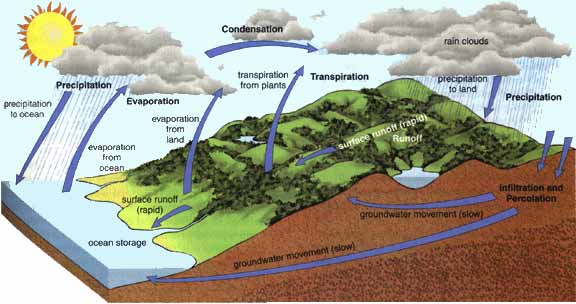| |
Though water is essential for all life on earth, most of it is salt water and, of the total amount of fresh water, only 2% is available for drinking. The rest is in the form of polar ice.
We live in a world in which water pollution has come to play an almost integral role. Most human populations will be forced to drink some form of treated water (chlorinated, ozonated, filtered, etc.) by the middle of the next decade if this trend continues. We are composed of some 70% water by weight. Over an average life of 70+ yrs, at an average weight of 120 pounds, we replace our entire body's worth of water some 1,600 times. It is important to understand that our bodes behave like large filters, removing environmental contaminants from the water we drink. Most of the contaminants that remain within us are fat-soluble and are deposited in adipose tissues. In contrast, water-soluble pollutants are more rapidly disposed of in urine and perspiration.
| |
 Photo by Dickson Despommier Photo by Dickson Despommier |
 Hudson River. Photo by Dickson Despommier Hudson River. Photo by Dickson Despommier |
Two percent of us (120 million) live near estuaries. "We all live downstream" carries with it a health warning when the pollutants that rivers carry as run off are deposited on our doorsteps (e.g., polychlorinated biphenyls in the Hudson River).
This is especially true for those that concentrate in food chains and food webs of aquatic organisms that we routinely harvest (e.g., fish and mollusks). Fat-soluble contaminants are slowly released into the circulation, usually after they have been chemically modified. Many harmful chemicals (e.g., DDT, lindane, benzopyrines) undergo chemical alterations that result in a small fraction of each contaminant being converted into various carcinogens. They then have the potential for interacting at the DNA level in concert with proto-oncogenes, inducing cancers in the process. Ecological processes concentrate contaminants in our food and water via the food chains and food webs.
Two excellent examples of environmental concentration are the insecticide, DDT, and strontium 90, a calcium analogue. When released into the environment, both of these water-soluble substances tend to accumulate sequentially in the tissues of phytoplankton, zooplankton, filter feeders, predators, and eventually humans. By the very act of ingesting food and drinking water, we become part of the food chains and webs that produced them.
Infectious disease agents are some of the most devastating contaminants of our water supplies. Most diarrheal diseases are waterborne, and infants, in particular, suffer from them in places throughout the world where the drinking water supply is routinely contaminated with human feces. In fact, more children die each year from diarrheal infections (some 10-15 million) than from any other single cause. Water pollution of various types continues to erode away the amount of potable water available to us, worldwide. Water is the single most valuable ecosystem service provided to us by natural systems, besides the production of oxygen by plants, but we are not yet united as a species in preventing further decay of this resource. The following applications will reveal the extent to which we need to remediate that service before water is once again a thing we can afford to take for granted.

Miller, Living in the Environment, 11th ed.
[Back To Top] |
|